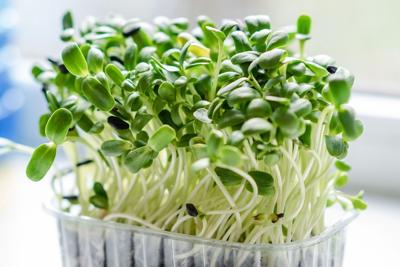
How much does your growing medium really impact your microgreens? More than you might think. The best growing medium for microgreens plays a crucial role in determining your cultivation success. Whether you're a novice gardener or seasoned grower, selecting the right foundation affects germination rates, growth speed, nutrient density, and flavor development.
This guide explores the most effective options available from traditional soil to innovative alternatives, helping you make an informed choice for your specific growing conditions.
By understanding the unique properties of each medium type, you'll be equipped to grow vibrant, flavorful microgreens that maximize both nutrition and taste in your culinary creations.
Soil-Based Options
Traditional soil remains a popular choice for microgreen cultivation due to its natural properties and accessibility. High-quality potting soil provides essential nutrients while retaining adequate moisture without becoming waterlogged. For best results, choose an organic potting mix that's lightweight and well-draining.
Many growers enhance basic soil by adding perlite or vermiculite to improve aeration, creating ideal conditions for delicate microgreen roots. Soil-based mediums are particularly forgiving for beginners, making them an excellent starting point.
Coconut Coir Benefits
Coconut coir has emerged as a sustainable alternative that excels at moisture retention while providing excellent drainage. Made from recycled coconut husks, this medium is environmentally friendly and naturally resistant to fungal growth.
Its neutral pH and ability to hold up to eight times its weight in water make it particularly suitable for microgreens that require consistent moisture levels. Coir's fibrous structure allows for optimal root development and aeration while being clean and easy to work with, making it increasingly popular among experienced growers.
Specialized Pre-Mixed Solutions
Purpose-designed microgreen mixes combine multiple components to create optimal growing conditions without experimentation. These professionally formulated mediums typically contain a balanced mixture of components like peat moss, vermiculite, and perlite, often enriched with mild organic nutrients.
Pre-mixed solutions offer consistency across growing cycles and minimize the risk of contamination. Though slightly more expensive than DIY options, they save time and provide reliable results, making them ideal for growers who prioritize convenience.
Hydroponic Growing Pads
Hydroponic pads offer a soil-free alternative that's clean, efficient, and perfect for indoor growing setups. Made from materials like hemp, jute, or biodegradable wood fibers, these pads provide excellent water absorption and root support.
The sterile nature of hydroponic growing reduces the risk of mold and disease while eliminating the mess associated with soil-based mediums. These pads work exceptionally well for fast-growing microgreens and ensure even germination, making them increasingly popular among urban growers with limited space.
Creating DIY Growing Mediums
Crafting your custom medium allows for complete control over components and can be cost-effective for regular growers. Successful homemade mixes often combine soil with organic materials like compost, worm castings, or peat moss to enhance nutrient content.
Adding components like perlite improves drainage, while a small amount of activated charcoal can prevent bacterial growth. While requiring more initial effort, DIY mediums can be tailored precisely to your needs and growing conditions, often yielding superior results once perfected.
Important Factors to Consider
When selecting a growing medium, consider moisture retention, aeration capability, and nutrient content. The ideal medium should hold enough water to support growth without becoming saturated, which can lead to mold or root rot.
Different microgreen varieties have specific requirements; some thrive with more moisture, while others prefer drier conditions. According to recent studies, factors such as seed treatments, seed density, and growing medium significantly influence the nutritional value of microgreens.
Environmental impact and sustainability are increasingly important considerations. Finally, your experience level should influence your choice, with beginners often finding greater success with forgiving options before advancing to specialized mediums.
Best Practices for Medium Maintenance
Proper maintenance of your growing medium helps ensure each crop of microgreens thrives. Always start with clean trays and fresh medium to reduce the risk of contamination. For soil and DIY mixes, avoid compacting the medium as this restricts root growth and decreases airflow.
Water evenly to maintain consistent moisture without oversaturating, and use a spray bottle or bottom-watering technique for delicate seedlings. If you're using hydroponic pads or coconut coir, monitor for signs of mold or salt buildup and replace or rinse materials as needed.
After each harvest, clean all equipment thoroughly before beginning a new cycle. Regular maintenance not only improves crop quality but also extends the life and effectiveness of your chosen medium.
Selecting the best growing medium for microgreens depends on a balance of your goals, experience level, and growing environment.
Whether you opt for traditional soil, sustainable coconut coir, hydroponic pads, or a custom DIY blend, the key is understanding how each medium supports healthy root development, moisture control, and nutrient access.
With the right medium, your microgreens will thrive by bringing vibrant color, flavor, and nutrition to your kitchen or business. Now that you’re equipped with the knowledge, it’s time to experiment and discover which growing medium delivers the best results for your setup.


(0) comments
We welcome your comments
Log In
Post a comment as Guest
Keep it Clean. Please avoid obscene, vulgar, lewd, racist or sexually-oriented language.
PLEASE TURN OFF YOUR CAPS LOCK.
Don't Threaten. Threats of harming another person will not be tolerated.
Be Truthful. Don't knowingly lie about anyone or anything.
Be Nice. No racism, sexism or any sort of -ism that is degrading to another person.
Be Proactive. Use the 'Report' link on each comment to let us know of abusive posts.
Share with Us. We'd love to hear eyewitness accounts, the history behind an article.